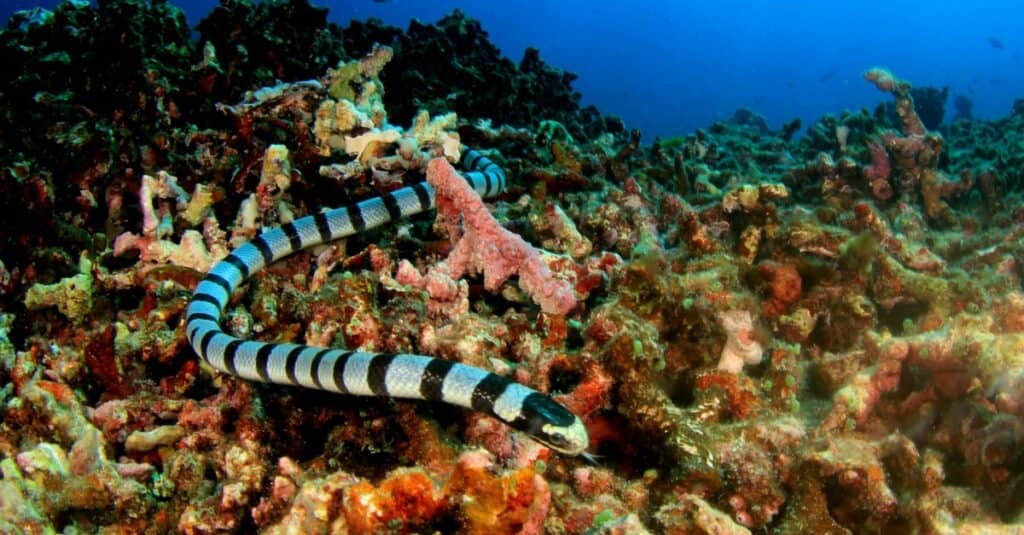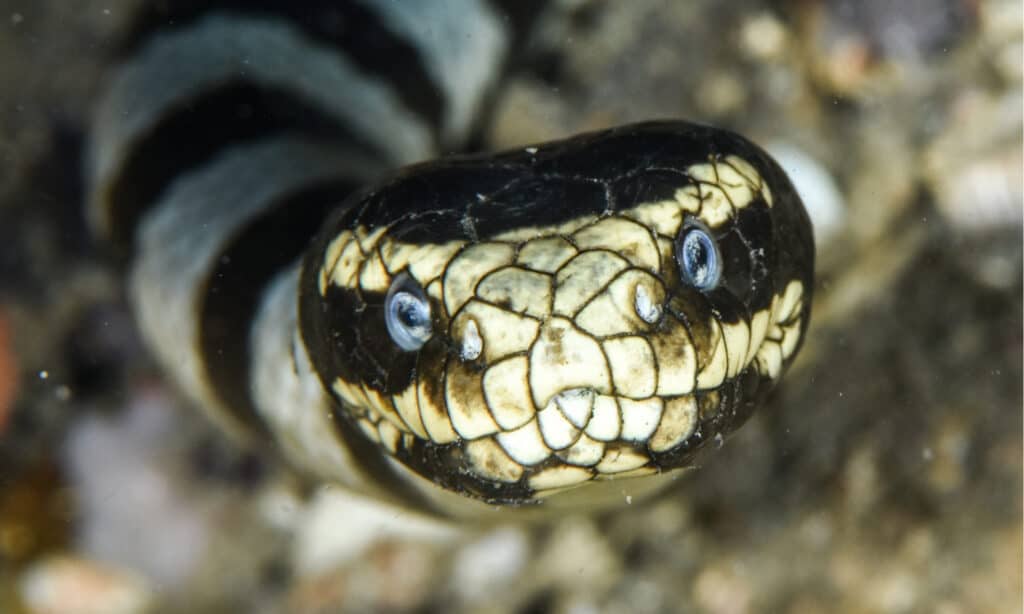For many people, snakes are frightening enough on land, but what about a snake swimming in the water? Better yet, how about hundreds of snakes on the prowl, swimming through the ocean together like an underwater pack of wolves? Well, that’s exactly what the extremely venomous Black Banded Sea Krait does when it’s time for dinner. While most snakes are solitary hunters, the black banded sea krait joins together in large packs to hunt, sometimes with groups numbering in the hundreds. Why does this extremely venomous sea snake attack in groups?
The Background on Sea Snakes
Most snakes can swim at least to some degree. However, sea snakes have taken swimming to a new Olympian level, living most of their lives entirely in the water! These snakes can be divided into two main groups: “True” sea snakes and sea kraits. True sea snakes live their entire lives in the ocean and never leave the water. They hunt, eat, mate, and give live birth in the water. Sea kraits, on the other hand, seem to be comfortable on land as well as in the ocean. However, sea kraits do not leave the water often. They only return to land to digest and rest, mate, shed, and lay eggs.
The black banded sea krait is an extremely venomous species of sea snake. In fact, black banded sea kraits are some of the most venomous snakes in the world! So why do they need to join with others to hunt in a pack?
Why This Extremely Venomous Sea Snake Attacks in Groups

Black banded sea kraits are uniquely adapted to live underwater.
©Rich Carey/Shutterstock.com
Black banded sea kraits are highly venomous, but they are relatively slow swimmers and need to return to shore occasionally. Because of this, they cannot hunt out in open ocean waters. Because catching fish head on is a difficult feat for these slower swimmers, they have developed an unexpected hunting strategy. Instead of hunting solo like most land and sea snakes, black banded sea kraits hunt together in packs, often with hundreds of other snakes.
However, that’s only the first part of their unique approach to underwater hunting. Black banded sea kraits take it a step further, not only forging alliances with members of their own species, but also with other fish like yellow goatfish and bluefin trevally. Apparently when you’re hunting with black banded sea kraits, the more the merrier.

Yellow Goatfish help to flush out small fish hiding in coral reefs.
©Albert kok, CC BY-SA 3.0, via Wikimedia Commons – License
What does this unique hunting group look like? Okay, here’s the plan: first, the yellow goatfish and bluefin trevally scare prey into coral reefs to hide. That’s when the black banded sea kraits make their move, hunting the fish and crabs now trapped in the cracks and crevices of the coral. The sea kraits bite and paralyze their prey with toxic venom before swallowing it whole.
And of course, any of the potential prey that might happen to escape the ravenous pack of sea snakes are instantly gobbled up by the yellow goatfish and bluefin trevally hungrily waiting behind them. It is a very efficient strategy for both sea snake and fish alike.
What Do Black Banded Sea Kraits Look Like?

Black banded sea kraits are shy and docile.
©Richard Whitcombe/Shutterstock.com
Black banded sea kraits are white or blue-grey with dark bands along their long bodies. In some kraits these bands can be quite distinct, while in others they are faded and brown, and older snakes may even have only partial bands. Female black banded sea kraits are much larger than males, measuring between 4.5-6 feet in length. Males on the other hand, are usually around 3 feet long.

Black banded sea kraits have adapted to better swim in the water.
©Ethan Daniels/Shutterstock.com
Although they can still travel on land, black banded kraits have evolved into very efficient swimmers, happily living most of their lives in the water. These kraits have long, narrow bodies that are tapered vertically like long, thin blades. Their tails are composed entirely of skin (there are no bones from the vertebral column) that extends out like a large fin or paddle. The krait’s long body, combined with this wide tail, provides it with an increased surface area that can propel and push against large volumes of water as it swims through the ocean.
Where Do Black Banded Sea Kraits Live?

Black Banded Sea Snakes live and hunt in coral reefs.
©DECOR 3D/Shutterstock.com
Black banded sea kraits have several different names: the Chinese sea krait, Chinese sea snake, and the Erabu or Irabu. These unique sea snakes live in ocean reefs, mostly in the warm waters of the Pacific Ocean and Indian Ocean. These sea snakes are found in the waters surrounding Singapore, Taiwan, China, southern Japan, Indonesia, and the Philippines.
In addition to their highly evolved external frames, sea kraits have also evolved an efficient internal physiology for life underwater. These snakes do not have gills and must come to the surface for oxygen every few hours. However, they have developed a long lung that can expand like a balloon and hold oxygen while underwater. Not only does this reserve provide the snake with oxygen while it is underwater, but it also helps the snake control its buoyancy so it can move up and down in the water.
Black banded sea kraits can also absorb one third of the oxygen they need just through their skin! The skin between their scales has a rich supply of blood vessels, allowing sea snakes to absorb oxygen directly into the bloodstream. Carbon dioxide is also purged through this skin surface, and any excess salt left in the body is released through glands in the snake’s mouth. These unique adaptations allow sea snakes to dive as deep as 300 feet below the surface of the ocean!
Are Black Banded Sea Kraits Venomous or Dangerous?

Black banded sea kraits are extremely venomous.
©Jack Pokoj/Shutterstock.com
Yes, the black banded sea krait is dangerous—in fact, the venom of this sea snake is ten times as potent as a cobra! However, black banded sea kraits are nocturnal and only hunt at night, so it is very unlikely you will ever come across one. Although they are highly venomous, black banded sea kraits are not at all aggressive. In fact, these sea snakes are very docile and shy. Their first instinct is to hide when they encounter anything potentially dangerous. They are slower swimmers, so if they don’t feel they can swim away fast enough, they will remain still, hoping that the threat will not see them. However, they can and will bite if they are taken out of the water, stepped on, or provoked. Most black banded sea krait bites happen to fishermen who accidently catch them in their nets.
The venom of the black banded sea krait is a deadly mix of myotoxins and neurotoxins that attack muscles as well as the nervous system. However, these sea snakes have tiny fangs, only about ¼ of an inch. In comparison, rattlesnakes have fangs that can reach over an inch long. Because of their tiny teeth, a bite from a black banded sea krait is often painless. However, bites require medical intervention and antivenom ASAP.
Conservation Status
The black banded sea krait is registered as “Near Threatened” on the IUCN Red list. Due to climate change, much of its native habitats and refuge sites have been lost. Scientists have reported several black banded sea kraits outside of their native range as they seek out new homes, near and around the waters of southern South Korea.
The photo featured at the top of this post is © Tomas Kotouc/Shutterstock.com
Discover the "Monster" Snake 5X Bigger than an Anaconda
Every day A-Z Animals sends out some of the most incredible facts in the world from our free newsletter. Want to discover the 10 most beautiful snakes in the world, a "snake island" where you're never more than 3 feet from danger, or a "monster" snake 5X larger than an anaconda? Then sign up right now and you'll start receiving our daily newsletter absolutely free.
Thank you for reading! Have some feedback for us? Contact the AZ Animals editorial team.






